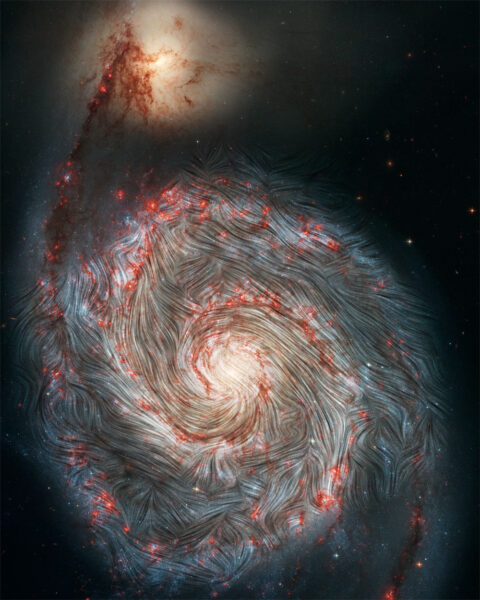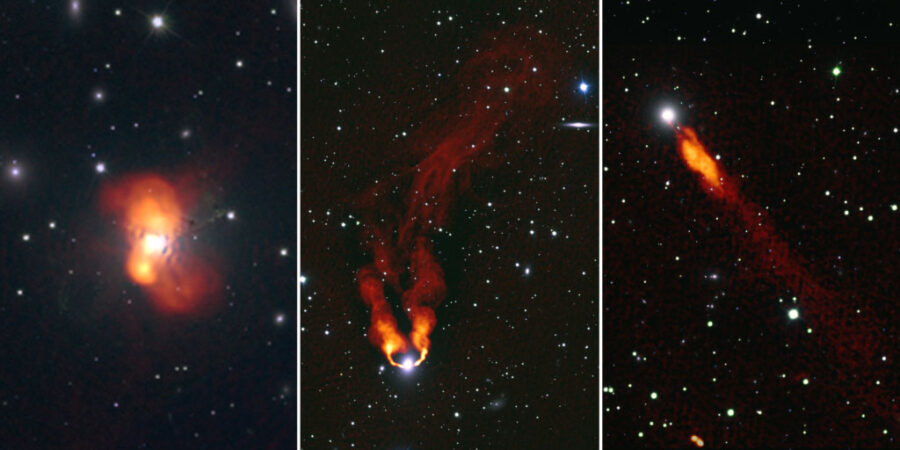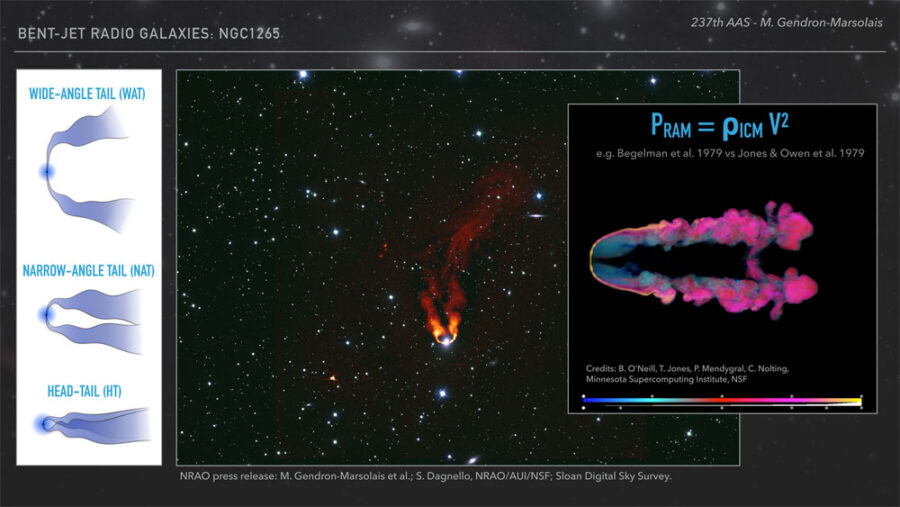In these stressful times we live in, cosmic images can provide some perspective. The images and visualizations below come from this week's virtual meeting of the American Astronomical Society and elsewhere.
Give yourself a break: Take a stroll through the Milky Way halo, peruse the Whirlpool Galaxy's magnetic field, spot an exoplanet's moon-forming disk, and admire the windblown jets powered by distant supermassive black holes.
Magnetic Whirlpool

SOFIA streamlines: NASA / SOFIA science team / A. Borlaff; background image: NASA / ESA / S. Beckwith (STScI) / Hubble Heritage Team (STScI / AURA)
The Whirlpool Galaxy (M51), 31 million light-years away in the constellation Canes Venatici, is a delight to observe. Now, NASA’s Stratospheric Observatory for Infrared Astronomy (SOFIA) has imaged the galaxy's polarized light in order to map out its magnetic field; the resulting magnetic streamlines are shown above.
While radio observations had shown that the magnetic field lines follow the spiral structure in the inner parts of the galaxy, SOFIA data shows for the first time that the magnetic field lines in the outer arms do not follow the same order. Intense star formation in these outer regions may be causing magnetic chaos, and the gravitational tug of neighboring galaxy NGC 5195 probably also plays a role.
— Monica Young
Windblown Jets

M. Gendron-Marsolais et al. / S. Dagnello (NRAO / AUI / NSF) / Sloan Digital Sky Survey
Marie-Lou Gendron-Marsolais (European Southern Observatory, Chile) wowed participants with her team’s latest radio images of galaxies in the Perseus Cluster. Lying about 230 million light-years away, Perseus is the brightest cluster in the X-ray sky and a long-studied target at multiple wavelengths. The astronomers collected the new high-resolution observations with the Karl G. Jansky Very Large Array in New Mexico, using the array’s largest, highest-resolution configuration.
Among the results are spellbinding images of bent jets, swept back from the galaxies’ cores like streamers billowing behind the galaxies as they plunge through the hot gas filling the cluster. Astronomers had thought that one of the galaxies, IC 310, had only a single, long tail, but the new images reveal there are two jets, bent back and seen at an angle that makes it hard to tease them apart.

Another galaxy, NGC 1275, shows complex filaments that connect its bright jets to a longer, curlicue trail that has puzzled astronomers since first discovered in 1998. It’s still unclear why the tail has the shape it does — maybe a combination of our viewing angle and twisting by shocks in the surrounding gas, Gendron-Marsolais said during her presentation on January 12th. The results also appear in the December 2020 Monthly Notices of the Royal Astronomical Society.
— Camille M. Carlisle
A Moon-forming Disk?

ESO / VLT / SPHERE / Van Holstein et al.
Astronomers first discovered a super-Jupiter orbiting the star DH Tau, pictured above, in an image taken in 2004. The giant world is at least 11 times Jupiter's mass and enormously far from its star — 10 times farther out than Neptune is from the Sun. But at just 2 million years old, it's so young that it still glows from the heat of its formation.
Now, Rob van Holstein (Leiden University and European Southern Observatory) and colleagues have measured the polarization of this infrared glow to watch its formation in action. The results will appear in Astronomy & Astrophysics (online preprint available).
The light is strongly polarized, which means the world's glow must be scattering off dust particles. This dust likely surrounds the planet in the shape of a disk, which means DH Tau b could be in the process of forming moons — though of course any moons around this planet remain unseen.
In another surprise, the disk is misaligned with the one that remains around the central star, so the researchers think DH Tau b formed at its extreme distance from the star, rather than forming closer in and migrating out. That means this massive world, which might even be massive enough to be a brown dwarf, would have collapsed directly from the gas cloud that formed the central star, in the same way that binary stars form.
— Monica Young
Streamers in the Milky Way Halo

A. Price-Whelan / A. Küpper / J. Diemand
The Milky Way has led a relatively quiet life, with no major mergers with other massive galaxies so far (the impending collision with the Andromeda Galaxy notwithstanding.)
Even so, our galaxy has had its fair share of social visits from dwarf satellites and star clusters. As these stellar clumps have fallen into the Milky Way, tidal forces pulled them apart into spaghetti-like streams that now decorate the halo surrounding our galactic disk. The Dark Energy Survey and the European Space Agency's Gaia mission have now enabled astronomers to discover these streams by the dozens. The visualization above, drawn from a simulation, shows just how many streams might exist in the Milky Way halo.

A. Price-Whelan
The Jhelum Stellar stream, shown in orange above, is one of the most recently discovered streams in the Milky Way’s inner halo. In addition to Gaia data, Allyson Sheffield (LaGuardia Community College) and colleagues made use of the APOGEE survey to determine the composition of the stars and thus help narrow down their origin. While they were not able to tie the stream to a specific galactic merger, they did establish that it wasn't part of the Gaia-Enceladus dwarf that came crashing into our galaxy some 9 billion years ago.
Read more about the result in the SDSS press release.
— Monica Young
 0
0









Comments
You must be logged in to post a comment.